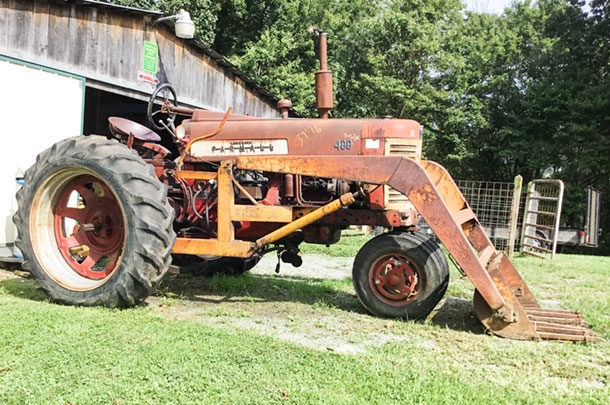Often, it’s hard to know whether we will find something good or find something that may just as well go straight to the scrap yard. As of late, scrap-yard caliber is what has been turning up. There is one exception, though, and that’s the Farmall 400 I found recently (which we’ll cover later).
Sometimes when we go “picking,” we find good donor tractors still mostly complete with some good parts but which have a very slim chance of ever running or being of any use again. Please keep in mind: The old, ugly, neglected, rusty, broken-down piece of equipment you are considering hauling off for scrap may just be what a collector has spent months or even years looking for.
If you find yourself in this predicament, please locate a collector organization near you or post a classified ad somewhere to at least give people a chance to see what you have and see if there is any interest in saving it from the scrap heap. You might just get more money for it this way too. I’d hate to know how much good stuff has met its end that way, and there is no replacing it once it’s gone.
One old tractor that has been very useful (and that we may have actually gotten our money’s worth over the years) is a 1956 International 300 Utility with the IH Torque Amplifier and fast-hitch systems. We bought it at a local auction several years ago, and it came with fast hitch implements including plow, scraper blade, mowing machine and the lift arm inserts to allow for the use of regular three-point hitch implements.
The tractor wasn’t running very well at all when we first got it, but after some carburetor work and some other fine-tuning, it was running great. Of course, there have been some odds and ends it’s needed – but overall it has been a very dependable and functional machine. It mostly gets used for garden plowing and box blade work, but you can just about guarantee it will fire right up and go every time you need it.
The row-crop version of the 300 Utility is the Farmall 300, and these came out following the Super H model. These tractors had a stout little 40 horsepower engine, but they were only built for two years. According to tractordata.com, the 3 millionth IH tractor produced was a 300 Utility in 1955.
Another tractor quickly becoming one of my favorites is the Farmall 400 I bought locally about a year ago. We received a tip about a tractor and some equipment that may be for sale but really had no clue what we would find once we got there.
So we went and, besides some very well used miscellaneous implements scattered around the barnyard, inside the barn were three tractors that had been parked for about four years. The one that sparked most of my interest was the 1956 Farmall 400 with a Freeman loader and the most complete fast-hitch setup I’ve seen on a barn-find Farmall.
The rest of the tractor was in pretty sad shape, though. Having been used on a dairy farm, it had a pretty hard life. It looked like most of its hydraulic fluid had leaked out on the ground, and the small sheet metal pieces around the dash were just dangling by some frayed wires that were still somehow connected.
The oil pressure and temperature gauges were missing, and the hood sheet metal had been removed, stood up against the barn wall, and the ends of each piece run over, presumably with one of the other tractors, rendering them useless without a lot of TLC. However, the oil, coolant and the gas in the tank looked great, and the engine was free. The rear tires were holding air, and the front tires were up and practically new.
After checking to see if there was enough wiring left to give it a chance at firing, we decided to give it a go. We tried but had no luck. We went back another day and changed the spark plugs, used the same old gas and, on the second crank, it fired right up.
The packing in one cylinder on the loader was bad, so it wouldn’t raise – so I backed it straight out of the barn and right on to the trailer for transport home. I still haven’t made any carburetor adjustments and, after a full service and a few leak repairs, it is doing just fine.
The 400 tractors replaced the Super M-TA Farmall and were painted solid red with chrome emblems. The best deal I found for replacement sheet metal though was from a 450; hence the white paint you see on the hood and grill.
The 400s were available with gas, L.P. gas and gas-start diesel engines as well as wheat land and high-clear chassis variations. The engines offered around 50 horsepower for your farming pleasure. The 300 and 400 make a nice pair, especially with them both being 1956 models. I’m sure these two tractors made a great team back in the day, and I’m glad to try and keep their tradition going for years to come. ![]()
PHOTO: Lance Phillips’ recent barn find – a 1956 Farmall 400 with Freeman loader. Photo by Lance Phillips.










